INSIGNIA AND DECORATIONS
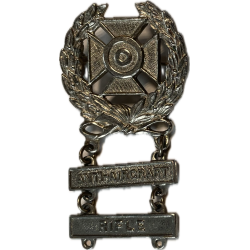
Badge, Anti-Aircraft, Rifle, Expert
Genuine WWII US Expert badge, with Anti-Aircraft, Rifle bars. Pin back. The U.S. Army created its first musketry proficiency badges circa 1880 to reward marksmen. According t the system enacted in 1921, three basic badges indicated the degree of proficiency, andadditional bars specific weapons or courses. The three badges were: - Marksman , Second-class Gunner. Minimum score of 60-77 % of points, depending on the weapon or qualification course. - Sharpshooter , First-class Gunner. 78-87 % of points. - Expert . 85-91 % of points.
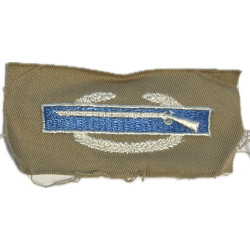
Badge, Combat Infantry (CIB), Cloth
Nice genuine WWII US Combat Infantry Badge, to be worn on dress uniform above the left front pocket. Made on cloth. 10cm. On October 27, 1943, the War Department formally established the Combat Infantryman Badge (CIB). The CIB was designed to enhance morale and the prestige of the 'Queen of Battle ' . Then Secretary of War Henry Stinson said: 'It is high time we recognize in a personal way the skill and heroism of the American infantry'. Retroactive award of Combat Infantryman Badge may be granted to any infantryman who, on or after December 6, 1941, has established eligibility and been recommended for such award.

Badge, Combat Infantry (CIB), Embroidered on felt
Nice genuine WWII US Combat Infantry Badge, to be worn on dress uniform above the left front pocket. Scarce embroidered on felt version. On October 27, 1943, the War Department formally established the Combat Infantryman Badge (CIB). The CIB was designed to enhance morale and the prestige of the 'Queen of Battle ' . Then Secretary of War Henry Stinson said: 'It is high time we recognize in a personal way the skill and heroism of the American infantry'. Retroactive award of Combat Infantryman Badge may be granted to any infantryman who, on or after December 6, 1941, has established eligibility and been recommended for such award.
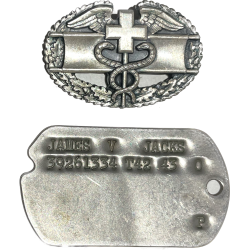
Badge, Combat Medic & Dog Tag, T/5 James Jacks, 13th Medical Bn. (Mountain), Merrill's Marauders, CBI
Genuine WWII US Army grouping, made up of a Combat Medic pin badge and a dog tag issued to James V. Jacks , ASN 39261334, vaccinated against tetanus in 1942-1943, blood type O, Protestant. James Verne Jacks was born on April 24, 1922 in Kansas City, Kansas and joined the US Army on October 31, 1942. He went on to serve with the Medical Department and deployed to Burma with Company A, 13th Medical Battalion (Mountain). He was discharged on February 8, 1946 as a Technician 5th Grade and passed away on August 22, 1988. In Burma, the 13th Medical Battalion (Mountain) was attached to 5307th Composite Unit (Provisional), a.k.a. 'Merrill's Marauders'. Under command of Brigadier General Frank D. Merrill , this special unit of the US Army was made up of about 3,000 volunteers who operated behind Japanese lines. In coordination with the Chinese forces, they fought in the jungle and mountains from February to August, 1944. The capture of Myitkyina Airfield was one of their most famous achievements. https://fr.findagrave.com/memorial/82513283/james-verne-jacks Illustration documents available in digital format only.
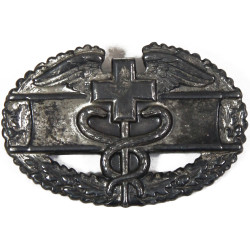
Badge, Combat Medic, US Army, Sterling
Genuine WWII US Army Combat Medic Badge, to be worn on the service dress or jump jacket. Issued to medics who served under enemy fire (see book Doc McIlvoy , page 161 for further information). Good overall condition. Pin is in working order.
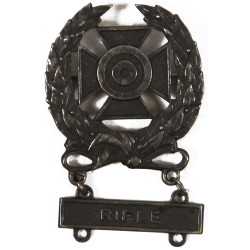
Badge, Expert, Rifle, Sterling
Genuine WWII US Expert badge , with Rifle bar. The U.S. Army created its first musketry proficiency badges circa 1880 to reward marksmen. According t the system enacted in 1921, three basic badges indicated the degree of proficiency, andadditional bars specific weapons or courses. The three badges were: - Marksman , Second-class Gunner. Minimum score of 60-77 % of points, depending on the weapon or qualification course. - Sharpshooter , First-class Gunner. 78-87 % of points. - Expert . 85-91 % of points.
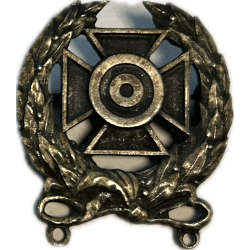
Badge, Expert, Sterling, PB
Genuine WWII US Expert badge , hallmarked Sterling, pin back. The U.S. Army created its first musketry proficiency badges circa 1880 to reward marksmen. According t the system enacted in 1921, three basic badges indicated the degree of proficiency, andadditional bars specific weapons or courses. The three badges were: - Marksman , Second-class Gunner. Minimum score of 60-77 % of points, depending on the weapon or qualification course. - Sharpshooter , First-class Gunner. 78-87 % of points. - Expert . 85-91 % of points.
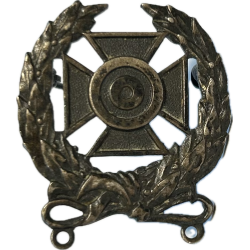
Badge, Expert, Sterling, PB
Genuine WWII US Expert badge , hallmarked Sterling, pin back. The U.S. Army created its first musketry proficiency badges circa 1880 to reward marksmen. According t the system enacted in 1921, three basic badges indicated the degree of proficiency, andadditional bars specific weapons or courses. The three badges were: - Marksman , Second-class Gunner. Minimum score of 60-77 % of points, depending on the weapon or qualification course. - Sharpshooter , First-class Gunner. 78-87 % of points. - Expert . 85-91 % of points.
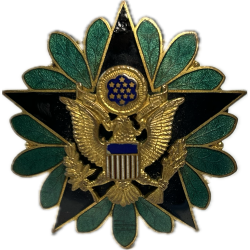
Badge, Indentification, War Department General Staff, N.S. MEYER Inc.
Scarce genuine WWII US War Department General Staff indentification badge. Created in 1933, it was worn on the upper right pocket of the service coat by officers of the Army who had served for at least one year in the War Department General Staff since June 1920.
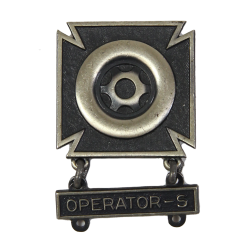
Badge, Motor Vehicles Badge, Operator-S, Sterling
Genuine WWII Motor Vehicles Badge, with OPERATOR - S (for special mechanical equipment) bar, hallmarked Sterling. This badge is to be worn above the upper left pocket of the service dress, below the ribbons. Pin back. Created in July 1942, the Motor Vehicles Badge is a U.S. Army reward issued to drivers, mechanics and special equipment operators to denote the attainment of a high degree of skill in the operation and maintenance of motor vehicles. The bars which are issued to the Motor Vehicles Badge are as follows: DRIVER - A (for amphibious vehicles) DRIVER - M (for motorcycles) DRIVER - T (for tracked vehicles) DRIVER - W (for wheeled vehicles) MECHANIC (for automotive or allied vehicles) OPERATOR - S (for special mechanical equipment)
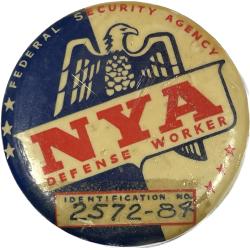
Badge, National Youth Administration
Genuine WWII. National Youth Administration badge. World War II had a broad impact on the social programs of Federal Security Agency. The Federal Security Administrator served as coordinator of the Office of Health, Welfare, and related Defense Activities, which provided health care, education, and related services necessitated by the war effort. 5.5cm.
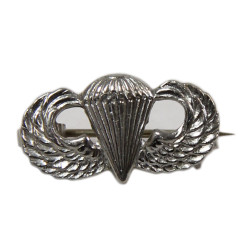
Badge, Parachutist's, 'Jump Wings', Silver, US Army, Miniature, Pin Back, Mint
Great genuine WWII US Army 925 silver alloy 'jump wings', miniature version (20mm). Mint, unissued condition. Pin is in working order.





